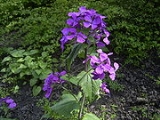
Annual honesty
Encyclopedia
Annual Honesty is a tall (height about 1 m), hairy-stemmed biennial plant
native to the Balkans
and south west Asia, and naturalized throughout Europe
, North America
, and parts of Asia
. It has large, pointed oval leaves with marked serrations. The common name "Honesty" arose in the 16th century, and it may be due to the translucent seed-pods which are like flattened pea-pods and borne on the plant through winter. In South-East Asia, it is called the "Money Plant," and in the United States as "Silver dollars," because its seed pods have the appearance of silver coins. In Denmark it is known as Judaspenge and in The Netherlands as Judaspenning (coins of Judas), an allusion to the story of Judas Iscariot
and the thirty pieces of silver
he was paid.
Biennial plant
A biennial plant is a flowering plant that takes two years to complete its biological lifecycle. In the first year the plant grows leaves, stems, and roots , then it enters a period of dormancy over the colder months. Usually the stem remains very short and the leaves are low to the ground, forming...
native to the Balkans
Balkans
The Balkans is a geopolitical and cultural region of southeastern Europe...
and south west Asia, and naturalized throughout Europe
Europe
Europe is, by convention, one of the world's seven continents. Comprising the westernmost peninsula of Eurasia, Europe is generally 'divided' from Asia to its east by the watershed divides of the Ural and Caucasus Mountains, the Ural River, the Caspian and Black Seas, and the waterways connecting...
, North America
North America
North America is a continent wholly within the Northern Hemisphere and almost wholly within the Western Hemisphere. It is also considered a northern subcontinent of the Americas...
, and parts of Asia
Asia
Asia is the world's largest and most populous continent, located primarily in the eastern and northern hemispheres. It covers 8.7% of the Earth's total surface area and with approximately 3.879 billion people, it hosts 60% of the world's current human population...
. It has large, pointed oval leaves with marked serrations. The common name "Honesty" arose in the 16th century, and it may be due to the translucent seed-pods which are like flattened pea-pods and borne on the plant through winter. In South-East Asia, it is called the "Money Plant," and in the United States as "Silver dollars," because its seed pods have the appearance of silver coins. In Denmark it is known as Judaspenge and in The Netherlands as Judaspenning (coins of Judas), an allusion to the story of Judas Iscariot
Judas Iscariot
Judas Iscariot was, according to the New Testament, one of the twelve disciples of Jesus. He is best known for his betrayal of Jesus to the hands of the chief priests for 30 pieces of silver.-Etymology:...
and the thirty pieces of silver
Thirty pieces of silver
Thirty pieces of silver was the price for which Judas Iscariot betrayed Jesus, according to the Gospel of Matthew 26:15 in the Christian New Testament. Before the Last Supper, Judas went to the chief priests and agreed to hand over Jesus in exchange for 30 silver coins...
he was paid.
See also
- Perennial honestyPerennial honestyPerennial Honesty is a tall , hairy-stemmed perennial found throughout Europe in damp woods, and on lime. It has large, pointed oval leaves with marked serrations...
, Lunaria rediviva - Dame's Violet, Hesperis matronalis, a similar and related plant, but with long cylindrical seedpods instead of flat papery disks.

